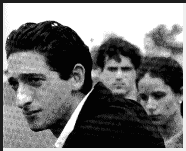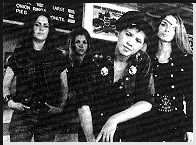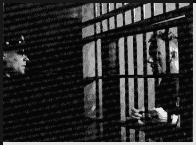|
| |

Contents | Features | Reviews | News | Archives | Store
Failing Independents,
Bad 'Toons, and More ...
If the question is
how to get your independent film recognized at a film festival this year, the answer seems
to fall along the lines of: mimicking Tarantino's violence-with-a-smile sensibility and
then filtering it through the Scorsesean motif of the high personal cost of being loyal to
your criminal community.
 All too often the net result on screen is charmless. The disease has been latent,
but is now approaching epidemic proportions. There is a surfeit of first-time directors
whose idea of making that 'deep personal statement' consists of nothing more than merely
forming a quorum of losers with exaggerated Noo Jirsey/Brooklynese accents, placing them
in a bruisingly-large late-model sedan on its last legs (wheels?) and ensuring that their
moral dilemmas are sufficiently ambiguous to inspire whatever little narrative suspense
can be mustered under these depressing circumstances. And, if you can set the film in the
worst sections of Newark, so much the better for generating 'instant atmosphere'. All too often the net result on screen is charmless. The disease has been latent,
but is now approaching epidemic proportions. There is a surfeit of first-time directors
whose idea of making that 'deep personal statement' consists of nothing more than merely
forming a quorum of losers with exaggerated Noo Jirsey/Brooklynese accents, placing them
in a bruisingly-large late-model sedan on its last legs (wheels?) and ensuring that their
moral dilemmas are sufficiently ambiguous to inspire whatever little narrative suspense
can be mustered under these depressing circumstances. And, if you can set the film in the
worst sections of Newark, so much the better for generating 'instant atmosphere'.
Aside from promoting the stereotype of New Jersey as an area that exists
only to provide low-level gangsters and high-level toxic waste (which may be true to a
certain extent, but, as my friends from New Jersey are always quick to inform me, there are
nice areas in the state), the films are so dull you can slice them - or, rather, you
would, if there was anything palatable to be gained from the procedure.
Among the really egregious offenders is Eric Bross's debut film, the
ineptly titled and even-more-ineptly-executed Nothing to Lose. It is nothing more
than a combination of the structures of Scorsese's Who's That Knocking At My Door?
and Mean Streets without any of their intelligence and spirit. Renting these
films instead of seeing Bross's piece of celluloid harlotry would be a much more sensible
idea. Laurence O'Neil's Throwing Down tries to disguise its debts to Scorsese and
Tarantino by moving the action halfway through the film to a cabin in Virginia, assuming
that the addition of low-life hicks is a useful compliment to the low-life Noo Yawkers who
make a habit of selling shavings from urinal deodorant blocks as high-grade coke. It
isn't, and they aren't.
On the brighter side of the underside of
life, Alan Taylor's Palookaville is several cuts above its competition. We've all
seen this sort of thing before - robbing an armored car is seen as a desperate group's
ticket to somewhere better than where they currently are (shades of last year's Heat and Siodmak's Criss Cross) - but Taylor
invests some highly valuable time in creating well-rounded characters for whom an audience
can feel some sort of empathy, and his gamble pays off. The usually sardonic tone that one
finds in these sorts of films has been softened to a more ironic stance; most of the
characters in Palookaville know that the joke of life is on them. They are the
rankest of amateurs up against 'the system', but, to their surprise, they discover that
the system isn't necessarily any more competent than they are; it simply has more force at
its disposal.
 The midnight screenings have been of the consistency expected from products that
melt evenly on a piece of bread under a broiler, and have been as satisfying. Jack Hill's
1975 exploitation classic, Switchblade Sisters, is loaded with deliciously bad
acting and scripting, not to mention the requisite 1970s wardrobe (bell bottoms, platform
shoes, mismatched patterns on that space-aged fiber known as bulletproof polyester - is
anybody breaking out in hives yet?). As if Mr. Tarantino hadn't enough of a presence,
however indirect, at this year's festival, his company, Rolling Thunder, is responsible
for the re-release of Switchblade Sisters, presumably to improve our intellects.
If the film makes it across the pond, watch in the final credits for the name of one Tak
Fujimoto, then a second unit cameraman, now Jonathan Demme's cinematographer of choice. The midnight screenings have been of the consistency expected from products that
melt evenly on a piece of bread under a broiler, and have been as satisfying. Jack Hill's
1975 exploitation classic, Switchblade Sisters, is loaded with deliciously bad
acting and scripting, not to mention the requisite 1970s wardrobe (bell bottoms, platform
shoes, mismatched patterns on that space-aged fiber known as bulletproof polyester - is
anybody breaking out in hives yet?). As if Mr. Tarantino hadn't enough of a presence,
however indirect, at this year's festival, his company, Rolling Thunder, is responsible
for the re-release of Switchblade Sisters, presumably to improve our intellects.
If the film makes it across the pond, watch in the final credits for the name of one Tak
Fujimoto, then a second unit cameraman, now Jonathan Demme's cinematographer of choice.
Another Tarantino-inspired film is Back to Back, about a couple of
yakuza who are attempting to enforce a debt owed by an American mobster and in the process
get in the way of a corrupt cop, who in turn has been putting the screws to a former
colleague of his. Then the colleague and the yakuza team up. It's always entertaining, but
one of the highlights is a cameo by comedian Bobcat Goldthwait, playing a crazed bank
robber whose demise is violently spectacular. Let's just say he provides new insight into
the expression 'blowing your top'.
Also violent and spectacular is
James Woods' performance as serial killer Carl Panzram in Tim Metcalfe's film, Killer:
A Journal of Murderer (Metcalfe wrote the serial-killer film, Kalifornia,
some three years ago), based on Panzram's memoirs as collected and published under the
same title. Panzram's case was unique, not least of all because he was allowed to dictate
his story under the auspices of prison guard Henry Lesser, who provided Panzram with
pencil and paper in contravention of prison regulations.
 The document that emerged was worthy of that much-abused adjective, 'shocking',
as it provided a most unpleasant set of insights into not only the psychopathology of
familial abuse, but the scarifying conditions that existed (and probably continue to
exist) in the American penal system. In an interview, director Metcalfe downplayed the
psychological and social aspect of the story, and expressed a belief that the film's
emphasis is centered more upon the naivete of Lesser's liberal do-goodism and its
inadequate response to the unadulterated and irremediable evil of Panzram who, in his
writings, inadvertently revealed his own suspicions that he was born evil. In my opinion,
this film accomplishes both tasks effortlessly. The document that emerged was worthy of that much-abused adjective, 'shocking',
as it provided a most unpleasant set of insights into not only the psychopathology of
familial abuse, but the scarifying conditions that existed (and probably continue to
exist) in the American penal system. In an interview, director Metcalfe downplayed the
psychological and social aspect of the story, and expressed a belief that the film's
emphasis is centered more upon the naivete of Lesser's liberal do-goodism and its
inadequate response to the unadulterated and irremediable evil of Panzram who, in his
writings, inadvertently revealed his own suspicions that he was born evil. In my opinion,
this film accomplishes both tasks effortlessly.
Guiltier pleasures awaited in the form of Politically Incorrect
Cartoondaze, a collection of animated shorts from the '30s, '40s and '50s as compiled
by animation historian/expert Jerry Beck. Since one of the programs of shorts was devoted
to controversial racial and sexual stereotypes, and the films' copyright holders are
understandably uneasy about their public screenings, Beck was obliged to use the holdings
of private collectors, themselves understandably reluctant to let the copyright holders in
on their secret collections.
Among the revelations provided in the pre- and post-screening
discussions was the existence of a list of eleven animated shorts that are deemed to be so
racially offensive that access of any sort is made very difficult, if not impossible. The
list, and several of these films, are now the property of cable magnate Ted Turner (I can
personally attest to the roadblocks that the Turner organization placed in my path when,
not knowing about the list, I foolishly attempted to obtain a copy of one of the
proscribed cartoons for research purposes. Fortunately, other institutions, and
individuals, were far more obliging). Needless to say, at least three of the films on that
list, including a print of Bob Clampett's classic 1942 parody of "Snow White",
"Coal Black and de Sebben Dwarfs", were shown.
Beck's response to charges that these cartoons promote offensive
stereotypes is to forthrightly acknowledge the obvious: yes, they do, and they should not
be shown at all on network television, nor shown at other venues, such as museums or film
festivals, without prior explanation of the historical context that surrounded their
production and the mentality that informed their production. But to deny their existence,
or to prevent access to scholars and cartoon buffs, is to deny the truth about the overt
racism that permeated American society prior to the Civil Rights movement. As one
African-American man in the audience stated after the screenings, whether Americans like
it or not, this is their history. I couldn't agree more.
Finally, festival life would not have been
complete without Russ Hexter's immaculately-constructed documentary about the effects of
socio-economic change in a place named Dadetown.
Hexter and crew explore, with painstaking skill, how Dadetown residents react to the
interruption of their traditional way of life when a high-tech company replaces the
traditional low-tech firms as the town's chief source of revenue, providing the locals
with cappuccino shops and upscale boutiques that they can't afford to frequent.
 The residents' resentment against the privileged newcomers possesses a nice
subliminal seething, fearful of social change and the loss of power that came from being a
member of a cohesive social group. For their part, the newcomers' attitude is one of
bringing 'culture' to a group of ungrateful savages. With their massive homes symbolically
located outside of town, and their unquiet pride in being able to get more home for less
money, they fail to understand the old ironic axiom of trying to get away from it all
while taking it with you. To a person, they claim to revere the innocence of small-town
life while simultaneously trying to change everything about it - except for the crime
rate. Unfortunately, no one is immune from this latter element as the tensions begin to
rise. The residents' resentment against the privileged newcomers possesses a nice
subliminal seething, fearful of social change and the loss of power that came from being a
member of a cohesive social group. For their part, the newcomers' attitude is one of
bringing 'culture' to a group of ungrateful savages. With their massive homes symbolically
located outside of town, and their unquiet pride in being able to get more home for less
money, they fail to understand the old ironic axiom of trying to get away from it all
while taking it with you. To a person, they claim to revere the innocence of small-town
life while simultaneously trying to change everything about it - except for the crime
rate. Unfortunately, no one is immune from this latter element as the tensions begin to
rise.
The depiction of violence and resentment is not, however, the only
unfamiliar element in this documentary, but one of several, as becomes evident all too
quickly. For the first twenty minutes, Dadetown plays like one of the worst
hackneyed celebrations of small-town Americana imaginable, full of the usual bucolic
imagery encompassing the town hall and paeans to the lifestyle's presumed innocence. Then,
to quote a favorite line from a Tex Avery cartoon (in turn borrowed from an Old Gold
cigarette advertisement), it slowly becomes obvious that "something new has been
added". All expectations should be put on permanent hold as a newer, more subversive
mindset begins to creep into the picture, like a serpent in the Norman Rockwell garden
(there's a good reason why, and, for those who want the answer, it is located just below (*) next week's trailer...). Another 'unfortunately'
must be added to Dadetown: Hexter died four weeks ago of an aneurysm, so his
debut is, sadly, his swan song.
Next Week: There's more than gold in them thar hills, as
John Sayles invites us to experience the complex interrelationships in a small Texas town
in Lone Star; Doug Pray's documentary, Hype!, explores the development of grunge music as
the element that briefly made Seattle the center of the musical universe in the early
'90s; and girls make more than film with Celestial
Clockwork, Sudden Manhattan
and I Shot Andy Warhol (finally).
That's right - Dadetown is a 'mockumentary',
complete with a 'cast list' in the end credits. There is no Dadetown in New York State and
all of the events and people portrayed are, as they say, fictional. Knowing this does not
make the film any less effective in its portraiture, however. If anything, the knowledge
allows the viewer to admire the subtlety of approach to Hexter's sleight-of-hand concept.
Contents | Features
| Reviews | News | Archives | Store
Copyright © 1999 by Nitrate Productions, Inc. All Rights
Reserved.
| |
|